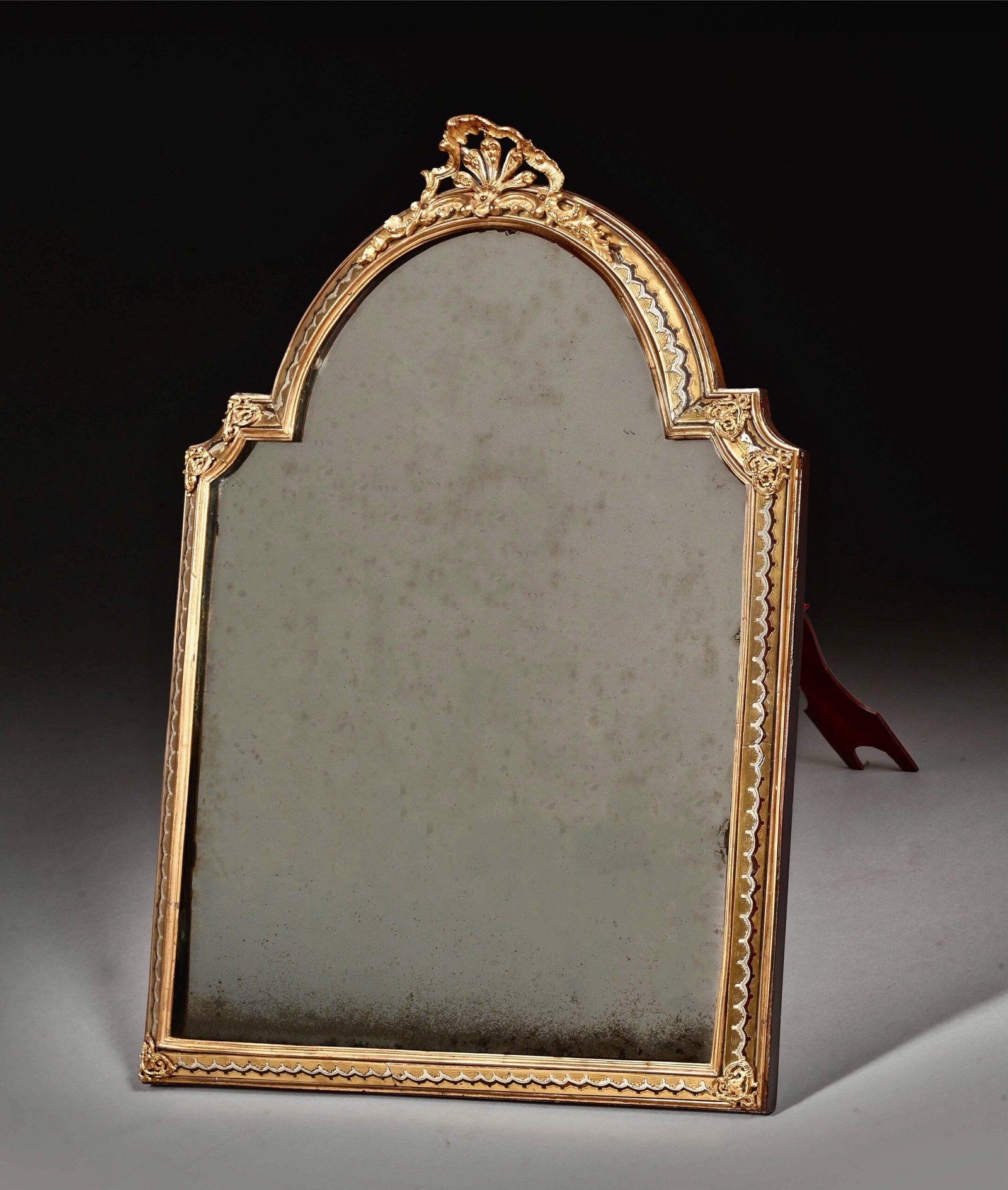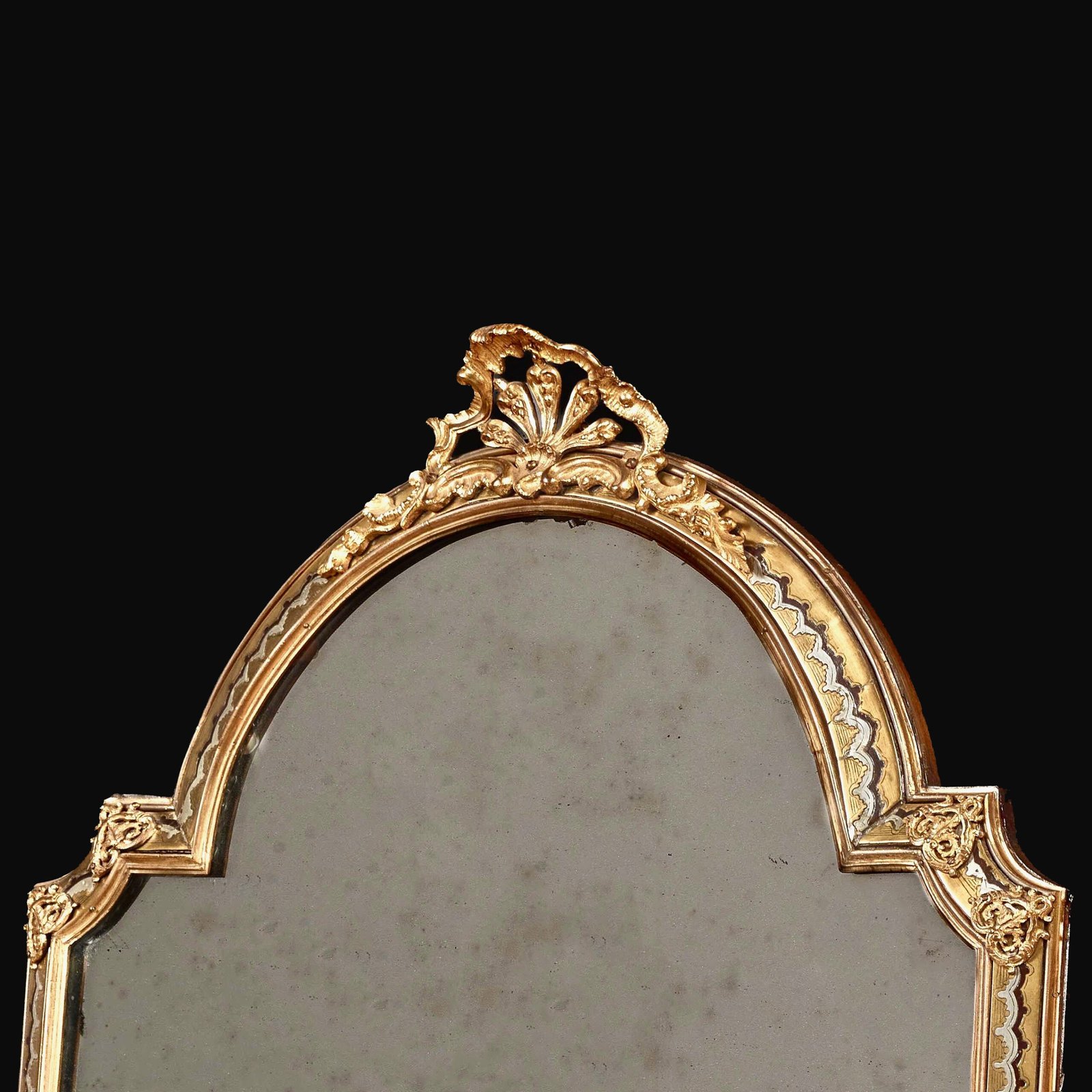Boulle marquetry toilet mirror
- Description
- Histoire
France, Louis xiv period
Boulle marquetry – brass, pewter and tortoiseshell
Chased and gilt bronze
Height: 68 cm – 27 inches
Width: 52 cm – 20 ½ inches
Depth: 5 cm – 2 inches
The tulipwood veneered back has a support to lay the mirror and a ring at the top to hang it.
Mirrors in the 17th century
At the end of the 15th century, the technique of making mirrors known as "au mercure" appeared in Italy, on the island of Murano. It was the only method capable of producing high-quality mirrors of substantial size.
A mixture of tin and mercury was applied hot onto a glass plate. This process was highly toxic and cost the lives of many workers. It was replaced in 1837 by the silverware technique and was eventually banned in 1850.
The Republic of Venice jealously guarded its monopoly on these luxury objects, making their importation extremely expensive (30,000 old pounds per year).
Wishing to make France self-sufficient in the arts and manufacturing, Jean-Baptiste Colbert, Minister of Finance under Louis xiv, sent spies to Murano and brought Venetian craftsmen to the Faubourg Saint-Antoine between 1665 and 1667 at great expense. These workers risked the death penalty from the Venetian Republique if they revealed the secret of mirror-making.
It was during this time that the Manufacture Royale de glaces de miroirs was created. It was relocated near Cherbourgin 1668, obtaining the exclusive privilege of manufacturing "glasses of mirrors”. Using the technique of "verre blanc soufflé en manchon [blown white glass]”, the Manufacture Royale was from that point able to compete with Venetian productions.
To obtain flat glass, craftsmen first blew the glass into a hollow bottle shape, called a "sleeve". The ends were cut off, then the cylinder was sliced lengthwise and unfolded to create a flat sheet of glass.
With 357 exceptionally large mirrors made for the Galerie des Glaces, completed in 1684, Luxury à la française was firmly established. In 1695, the factory merged with another one located on the site of the former Château des Sires de Coucy, in Saint-Gobain, in the Aisne region.
By the end of Louis xiv’s reign, the mirror industry, led by the Manufacture royale de glaces de miroirs, was exporting mirrors across Europe, generating revenues equivalent to 300,000 to 400,000 livres old pounds per year. Thus, the Venetian monopoly was replaced by the French monopoly.
The Manufacture royale de glaces de miroirs lost its privileges during the Revolution. It later transformed into what is now Saint-Gobain.
A miroir de toilette
The fashion for toilet services probably appeared during the first half of the 17th century at the French court. The word “toilet” which first designated the cloth (the canvas) that covered the table where the care utensils were placed, gradually applied to the rite of changing the linen. Indeed, while public baths were frequent in the Middle Ages, they gradually disappeared during the Renaissance. Taking a bath then became a rare practice. Only a few large castles had “bathing apartments” and in the cities “bathhouses”.
Scarce in the cities and often foul smelling, water was feared. The “dry” toilet developed gradually at this time, consisting in wiping oneself with soft and white fabrics, perfumes or ointments. Responding to these practices, more and more refined objects ended up constituting what we call from then on the “toilet services” of which the mirror constitutes one of the major elements. Conceived to rest on a table, this mirror is provided with a support mounted at the back.
The improvement of the manufacturing method of the glass mirror in the 17th century let to obtain larger and larger surfaces which were decorated with a luxurious frame.
Bibliography
- Graham Child, Les miroirs, 1650–1900, Paris, Flammarion, 1990.
- Nicolas Courtin, L’art d’habiter à Paris au xviie siècle, Paris, Éditions Faton, 2011.
- Nadeije Laneyre-Dagen, Georges Vigarello, La toilette, La naissance de l’intime, catalogue d’exposition Musée Marmottan, 2015.
- Georges Vigarello, Le propre et le sale : l’hygiène du corps depuis le Moyen Âge, Paris, Seuil, 1985.

